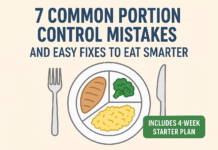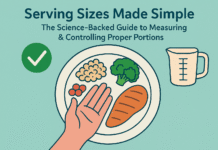Short on time but big on goals? High-intensity interval training (HIIT) squeezes serious fitness benefits into tiny training windows—often just 10 minutes. In this guide, you’ll learn what truly counts as “high intensity,” how to warm up and stay safe, and exactly how to run multiple 10-minute HIIT formats at home—no gym required. The plans, progressions, and troubleshooting tips are designed for busy beginners through intermediates who want efficient, measurable results without sacrificing form or recovery.
Medical disclaimer: The information below is general education, not medical advice. If you have a health condition, take prescription medications, are pregnant, or have concerns about vigorous exercise, consult a qualified healthcare professional before starting.
Key takeaways
- Ten minutes can work when intensity is high and movements are chosen wisely—especially if you add light/moderate activity on other days to round out your week.
- Intensity matters more than novelty. Use the talk test, RPE (effort out of 10), and—if available—heart-rate ranges to keep intervals truly “vigorous.”
- Technique > speed. Clean reps at high effort beat sloppy reps at all-out chaos. Scale impact and load to your current level.
- Recover to improve. Short workouts still create fatigue. Space hard HIIT days, sleep well, and keep easy days easy.
- Track simple metrics. Reps completed, average RPE, heart-rate peaks, and how quickly breathing calms post-interval are practical progress markers at home.
What HIIT Is—and why 10 minutes can be enough
HIIT alternates very hard work intervals with easier recovery intervals. That structure lets you accumulate time at a challenging intensity without collapsing two minutes in. Well-designed HIIT boosts aerobic capacity, power, and metabolic fitness in less time than steady, moderate exercise. Research also shows brief protocols—sometimes as little as one minute of hard work within a 10-minute session—can drive meaningful improvements when progressed over weeks. The catch? The “I can barely say more than a word or two” kind of hard work. That’s the lever.
Core benefits in plain English
- Cardio fitness, fast. Intervals pull your heart and lungs into higher gears, improving conditioning efficiently.
- Metabolic perks. HIIT is linked with improvements in insulin sensitivity and blood-pressure markers, particularly in people who need it most.
- Afterburn (EPOC). Post-workout oxygen use can remain elevated for a while after hard intervals, adding a modest energy-use bump.
- Habit-friendly. Ten minutes is easy to schedule. Consistency beats “perfect” any day.
Common misconception: Ten minutes of anything won’t outperform longer, moderate training for every goal. Consider your weekly total. Short HIIT is an excellent anchor, not the entirety of an active life.
Who this is for—and what you need
You’ll love 10-minute HIIT if you:
- Want efficient conditioning with minimal gear.
- Prefer home workouts you can finish between work calls, naps, or errands.
- Like measurable, short blocks instead of long grind sessions.
Basic setup
- Space: 2×2 meters of clear floor.
- Optional gear: A pair of dumbbells or a kettlebell, a mat, a step/bench, and a stationary bike or jump rope if you have them.
- Timer: Phone timer or interval app.
- Footwear: Supportive shoes, or barefoot for low-impact strength sequences if your surface allows.
- Tracking: Notebook/app for reps, RPE, and heart rate if available.
Low-cost swaps
- No weights? Use backpacks filled with books or water bottles.
- No step? A sturdy chair (check stability) or stair bottom step.
- No bike? Do fast marches, shadowboxing, or high-knee intervals.
How hard is “high intensity”? (So you don’t just “kinda try”)
Use three overlapping tools:
- Talk test
- Vigorous effort: Breathing hard; you can only speak a few words at a time.
- Recovery: Full sentences return.
- RPE (Rate of Perceived Exertion) 0–10
- Work intervals: Aim ~7–9/10 (hard to very hard).
- Recoveries: ~3–4/10 (easy to moderate) so you can hit the next interval.
- Heart rate (if you track it)
- Vigorous often corresponds roughly to about 77–93% of estimated max heart rate. Use ranges as guides, not commandments. If you don’t track HR, the talk test + RPE works extremely well.
Pro tip: Intensity is personal. What’s hard for you today may be different next week, and different from your friend’s “hard.” The test is whether you can sustain quality work across all intervals, not just the first burst.
Quick-start warm-up (3–4 minutes)
A short warm-up raises your body temperature, greases joints, and wakes the nervous system. Keep it dynamic:
- Easy march or jog in place – 60 seconds
- World’s greatest step (lunge + reach) – 30 seconds each side
- Hip hinge sweeps (soft-knee toe sweeps or good-morning pattern) – 30 seconds
- Plank walkouts – 4–6 reps
- 10 fast “rehearsal reps” of your first workout move at low effort
Cool-down: After your 10-minute HIIT, walk slowly for 60–90 seconds and breathe through the nose. Light mobility for hips, calves, and upper back is optional if it helps you feel better.
Safety first: prerequisites and caveats
- Start where you are. If you’ve been inactive, begin with the low-impact formats below.
- Spacing: Keep 24–48 hours between the hardest HIIT days.
- Stop if you feel chest pain, dizziness, or unusual shortness of breath.
- Joint-friendly rules: Land softly, avoid pain spikes, and swap jumps for marches or power step-backs when needed.
- Medical screens: If you have known cardiovascular, metabolic, or kidney conditions—or you’re unsure—get individualized clearance before vigorous intervals.
The 10-minute formats: pick your favorite—and rotate
Each format below includes seven parts: what it is & benefits, requirements, step-by-step, modifications, progressions, frequency/metrics, safety/mistakes, and a mini-plan you can follow today.
1) Tabata Bodyweight (20:10 × 8)
What it is & benefits
A classic: 8 rounds of 20 seconds hard / 10 seconds rest using one or two big movements. Benefits include powerful cardio stimulus, mental grit, and clean technique under fatigue when kept bodyweight.
Requirements
- Timer that lets you set 20/10.
- Space to move; shoes recommended.
Step-by-step
- Choose two moves that you can do well when tired (e.g., squat thrusts and mountain climbers).
- Alternate: Round 1 squat thrusts (20s), rest 10s; Round 2 mountain climbers (20s), rest 10s; continue to 8 rounds.
- Keep reps smooth—no “worming” through the core.
Modifications & progressions
- Simplify: Step back to a plank instead of jumping; hands on a bench for climbers.
- Progress: Use a weighted vest/backpack or advance to lateral bounds and burpees once landing stays soft.
Frequency & metrics
- 1–2×/week.
- Track total reps across all 8 rounds and average RPE. Try to match or beat total reps next time without sacrificing form.
Safety & mistakes
- Biggest error: letting hips sag in plank movements. Brace the ribs down gently and push the floor away.
Mini-plan
- Round 1–8: 20s squat thrusts / 10s rest alternating with 20s mountain climbers / 10s rest.
2) EMOM Strength-Cardio (Every Minute on the Minute)
What it is & benefits
Start a small “work set” every minute; rest in the leftover time. This format blends strength and cardio while auto-pacing your session.
Requirements
- Timer with minute beeps.
- Optional dumbbells.
Step-by-step (10 minutes = 10 rounds)
Minute 1: Goblet squats × 10 → rest to the top of the minute
Minute 2: Fast marches or high knees × 30–40 → rest
Alternate those two minutes until minute 10.
Modifications & progressions
- Simplify: Bodyweight squats; march in place.
- Progress: Add load to squats; switch marches to skater hops or jump rope.
Frequency & metrics
- 1–2×/week.
- Track weight used and if you earned ≥15 seconds of rest each minute.
Safety & mistakes
- Don’t chase reps so fast you lose depth or knee tracking on squats.
Mini-plan
- Odd minutes: 10 goblet squats. Even minutes: 30–40 high knees. Done.
3) AMRAP Metcon (As Many Rounds As Possible)
What it is & benefits
Circuit a few moves for 10 minutes straight, resting as needed. You’ll build work capacity and efficiency.
Requirements
- Timer for a 10-minute block.
- Open space, mat.
Step-by-step
AMRAP 10 minutes:
- 6 reverse lunges/side
- 8 push-ups (incline if needed)
- 12 hip hinges (good-morning pattern)
Rest 15–20 seconds only when form dips.
Modifications & progressions
- Simplify: Hands on a counter for push-ups; shorter lunge range.
- Progress: Add dumbbells to lunges and hinges; make push-ups deficit or tempo.
Frequency & metrics
- Up to 2×/week if you keep effort high and recovery solid.
- Count rounds + reps; record your pacing strategy.
Safety & mistakes
- Spinning your wheels on push-ups. If your last rep slows to a crawl, go incline sooner.
Mini-plan
- Set 10-min timer. Do the 6–8–12 circuit, resting briefly as needed.
4) Low-Impact HIIT (Joint-friendly)
What it is & benefits
All the sweat, less bouncing. Great for beginners, larger bodies, or sore joints.
Requirements
- Stable floor; shoes optional.
Step-by-step
Work 40s / rest 20s × 10 minutes, rotate moves:
- Power step-backs (athletic lunge pattern without a jump)
- Fast hands & feet (quick in-place steps with brisk arm drive)
- Standing knee drives (alternating)
- Hip hinge swings (no weight; snap to stand)
Repeat.
Modifications & progressions
- Simplify: Decrease range or speed.
- Progress: Add light dumbbells to hinge swings; increase arm speed on fast feet.
Frequency & metrics
- 2–3×/week works well if you’re new; intensity is still vigorous by breathing/talk test.
- Track breathing recovery—how quickly you can say a full sentence after each rest.
Safety & mistakes
- Letting knees cave during step-backs—drive the knee over the middle of the foot.
Mini-plan
- 40s on / 20s off rotating four low-impact moves, twice through.
5) Dumbbell HIIT (Total-body)
What it is & benefits
Pairs loaded patterning with fast movers for high-output conditioning.
Requirements
- One or two dumbbells you can front-rack comfortably.
Step-by-step
30s work / 15s rest × 10 minutes (6 rounds plus a bonus finisher if time remains):
- DB thrusters (squat → press)
- Fast mountain climbers
- DB bent-over rows
- High-knee run in place
Modifications & progressions
- Simplify: Single dumbbell held goblet-style; incline climbers.
- Progress: Heavier DBs or tempo thrusters; add a plank hand-tap to climbers.
Frequency & metrics
- 1–2×/week.
- Track load and total reps per movement.
Safety & mistakes
- Don’t over-arch on presses. Think “ribs down, glutes on.”
Mini-plan
- Alternate loaded and unloaded moves for 10 minutes, aiming for consistent rep tempo.
6) Kettlebell Power Intervals
What it is & benefits
Hinge-dominant power (swings) plus stability patterns deliver cardio without pounding.
Requirements
- One kettlebell you can swing for 15–20 safe reps.
Step-by-step
EMOM × 10 minutes:
- Odd minutes: KB swings × 15–20
- Even minutes: Bear crawl hold (on all fours, knees hovering) 20–30s, then breathe.
Modifications & progressions
- Simplify: Swap swings for hip hinge deadlifts.
- Progress: Heavier bell, or switch even minutes to front-rack reverse lunges.
Frequency & metrics
- 1–2×/week.
- Track swing quality (hard bell float, no shoulder lift) and how many seconds of rest remain each minute.
Safety & mistakes
- Squatting your swing. Hinge at the hips; shins almost vertical.
Mini-plan
- 10 minutes alternating swings with core-stability work.
7) Sprint-Shadowbox Intervals
What it is & benefits
Cardio power without equipment. Short “sprints” of footwork and punches spike heart rate and coordination.
Requirements
- Clear space; optional light wraps/gloves for feel.
Step-by-step
10 rounds of 30s hard / 30s easy:
- Hard: Shadowbox combos (jab–cross–hook–roll), fast feet
- Easy: Step and breathe, hands relaxed
Modifications & progressions
- Simplify: Slow combos with crisp technique; smaller range of motion.
- Progress: Add sprawl (burpee to plank) every 4–6 punches; or increase to 40s hard / 20s easy later.
Frequency & metrics
- 1–2×/week.
- Track combo count per hard interval and perceived crispness.
Safety & mistakes
- Don’t over-rotate the knee on hooks—pivot through the foot.
Mini-plan
- 5 minutes in, quick check: If punches are sloppy, extend your easy intervals slightly to recover quality.
8) Ladder Intervals (Up & Down)
What it is & benefits
Work intervals ramp up, then taper—great for pacing and confidence.
Requirements
- Timer capable of variable intervals.
Step-by-step
- 30s work / 30s rest (jumping jacks or rope)
- 40s work / 20s rest (squats)
- 50s work / 10s rest (plank shoulder taps)
- 60s work / 30s rest (alternating step-back lunges)
Then reverse the ladder to finish 10 minutes.
Modifications & progressions
- Simplify: Marching jacks; wall plank taps.
- Progress: Add light dumbbells on squats or a small hop on lunges.
Frequency & metrics
- 1×/week (it’s spicy).
- Track completion quality—can you hold form on the 50–60s sets?
Safety & mistakes
- Beware shoulder fatigue on long plank sets; shake out wrists between intervals.
Mini-plan
- Follow the ladder up and down once.
9) Mobility-Conditioning Blend
What it is & benefits
Pairs mobility flows with brisk output to build resilience without smashing joints daily.
Requirements
- Mat and a little floor space.
Step-by-step
45s on / 15s off × 10 minutes:
- World’s greatest lunge to rotation (flow)
- Fast step-overs (imaginary low hurdle)
- Hip airplane or supported hip openers
- Power marches
Repeat.
Modifications & progressions
- Simplify: Reduce depth and speed.
- Progress: Add a 5–10 lb load to marches or increase flow speed while keeping control.
Frequency & metrics
- 2–3×/week as an “easy” HIIT day.
- Track range quality (smooth, pain-free arcs) and breathing control under effort.
Safety & mistakes
- Don’t force end-range positions. Only move through ranges you can control.
Mini-plan
- Keep nasal breathing on the mobility moves; let mouth breathing ramp during the power marches.
10) Bike (or Step) REHIT
What it is & benefits
A minimalist protocol: very short all-out sprints within a 10-minute session on a bike (or fast step-ups). Excellent for time-crunched days.
Requirements
- Stationary bike preferred; a safe step alternative if cycling isn’t available.
Step-by-step
- Warm-up 2 minutes easy
- 20 seconds all-out → 2 minutes easy
- 20 seconds all-out → 2 minutes easy
- Cool down whatever time remains (or add a third sprint as you advance)
Modifications & progressions
- Simplify: Use “very hard” instead of “all-out.”
- Progress: Add a third 20s sprint or increase resistance modestly.
Frequency & metrics
- 1–2×/week.
- Track peak cadence/watts for each sprint and how fast HR/RPE fall afterward.
Safety & mistakes
- All-out means the rest must be truly easy. If your second sprint drops by >15–20% output, extend the recovery.
Mini-plan
- Two perfect sprints > three messy ones. Nail quality first.
How often should you do 10-minute HIIT?
- Beginners: 2 HIIT days/week + 2–3 easy movement days (walks, mobility, light cycling).
- Intermediates: 3 HIIT days/week max; separate the hardest formats by at least one easy day.
- Weekly activity picture: Short HIIT adds potent vigorous minutes, but you’ll likely still want easy/moderate activity to approach recommended weekly totals. Think of HIIT as the spark plug within an overall active week (walks, chores, play).
Troubleshooting & common pitfalls
“I don’t feel ‘wrecked’—did it work?”
HIIT should feel hard during the work intervals and recoverable between them. If you’re not breathing hard, increase effort, range, or load. If you’re wrecked after minute three, scale down and rebuild.
“My heart rate won’t go high enough.”
Some trackers lag. Use the talk test and RPE. Shorten intervals to 15–20 seconds and push harder, or choose movements that let you accelerate quickly (shadowboxing, rope, sprints on a bike).
“My joints hurt.”
Switch to low-impact options and reduce jumping. Keep knees tracking over mid-foot, hinge the hips, and land softly. Pain during a movement is a red flag—swap the move.
“I gas out early.”
Lengthen recoveries (e.g., 30s work / 30–40s easy). As fitness rises, shorten the easy periods.
“I stall on progress.”
Change one variable: load, interval length, density (more work minutes), movement difficulty, or total sessions per week. Keep two variables stable so you can see what worked.
How to measure results at home
1) Capacity metrics
- Total reps completed per session or per interval.
- Rounds + reps for AMRAPs.
- Average work-interval RPE at a given structure (e.g., 30/15).
2) Recovery metrics
- Breathing recovery: Can you speak a full sentence 45–60 seconds after a hard burst?
- Heart-rate drop: If you track HR, how many beats do you recover in the first minute post-interval over time?
3) Consistency metrics
- Sessions per week completed for four straight weeks.
- Movement quality: Fewer technical breakdowns late in the session.
4) Feel-good metrics
- Energy and sleep on days after HIIT.
- Stairs test: Are stairs easier after two to four weeks?
A simple 4-week starter roadmap
Principles: Keep the hard days separated, progress gently, and add easy movement on most days.
Week 1
- Mon: Low-Impact HIIT (40/20 × 10)
- Wed: EMOM Strength-Cardio
- Sat: Mobility-Conditioning Blend
- Plus: 2–3 easy 20–30 min walks any days
Week 2
- Mon: Tabata Bodyweight
- Thu: AMRAP Metcon
- Sat: Bike/Step REHIT (2 sprints)
- Plus: Walks or gentle rides 3 days
Week 3
- Tue: Dumbbell HIIT
- Fri: Low-Impact HIIT (slightly faster or a touch longer work bouts)
- Sun: Mobility-Conditioning Blend + optional 10-min core
- Plus: 2–3 easy movement days
Week 4
- Mon: Kettlebell Power Intervals
- Thu: Sprint-Shadowbox Intervals (30/30 × 10)
- Sat: Favorite format from Weeks 1–3, re-test and try to beat prior score with equal or better form
- Plus: Easy activity most days
After Week 4:
- Bump frequency to 3 hard sessions only if you’re sleeping well and progressing. Otherwise, keep 2 and build the easy-movement base around them.
FAQs
1) Can I really get results with just 10 minutes?
Yes—if intensity is high and you repeat the practice consistently. Many people see noticeable conditioning changes in 3–6 weeks. For broad health benefits, pair these bursts with more easy/moderate activity across the week.
2) How many days per week should I do 10-minute HIIT?
Two to three is plenty for most. More isn’t automatically better; recovery drives adaptation.
3) Do I need equipment?
No. Bodyweight formats work extremely well. Dumbbells or a kettlebell expand options, and a bike makes REHIT especially accessible.
4) I’m a beginner—where should I start?
Begin with the Low-Impact HIIT and Mobility-Conditioning Blend. Keep your work intervals at an RPE ~7/10 and recover until you can speak in full sentences.
5) Is jumping required for HIIT?
Not at all. You can achieve vigorous intensity with non-impact moves: fast marches, shadowboxing, cycling sprints, heavy hinges, and step-backs.
6) How do I avoid injury?
Warm up briefly, choose regressions that let you own each rep, keep landings soft, and stop any move that causes sharp or persistent pain.
7) What should I eat before a 10-minute HIIT?
If it’s first thing in the morning, a small glass of water and (if you prefer) a few easy carbs can help. If you’ve eaten recently, wait ~60–90 minutes so you’re not training on a full stomach. Hydrate.
8) What if I can’t hit the same numbers across intervals?
Totally normal. Either lengthen the recovery by 10–20 seconds or reduce the next work bout slightly. Consistent form beats chasing numbers.
9) Will HIIT help with fat loss?
HIIT can support fat loss by increasing energy expenditure and improving fitness, which may help you do more overall activity. Nutrition and total weekly movement remain the biggest levers.
10) Can I stack two 10-minute HIITs back-to-back?
Occasionally, yes—if you treat one as strength-tilted and the other as cardio-tilted. But most days, you’ll get more out of one sharp 10-minute session plus a longer, easy walk.
Conclusion
Ten minutes is enough time to train hard, get better, and feel proud—today. Use the formats you enjoy, measure something simple each session, and let progress come from consistency and smart recovery. Your fitness doesn’t need an hour; it needs intention.
References
- Physical Activity Guidelines for Americans, 2nd edition — U.S. Department of Health and Human Services. 2018. https://health.gov/sites/default/files/2019-09/Physical_Activity_Guidelines_2nd_edition.pdf
- Top 10 Things to Know About the Second Edition of the Physical Activity Guidelines for Americans — Office of Disease Prevention and Health Promotion. Aug 25, 2021. https://odphp.health.gov/our-work/nutrition-physical-activity/physical-activity-guidelines/current-guidelines/top-10-things-know
- Measuring Physical Activity Intensity — Centers for Disease Control and Prevention. Dec 6, 2023. https://www.cdc.gov/physical-activity-basics/measuring/index.html
- Know Your Numbers: Maximum and Target Heart Rate by Age — American Heart Association. Aug 12, 2024. https://www.heart.org/en/healthy-living/fitness/fitness-basics/target-heart-rates
- All About Your Heart Rate — Harvard Health Publishing. Jun 1, 2023. https://www.health.harvard.edu/heart-health/all-about-your-heart-rate
- Twelve Weeks of Sprint Interval Training Improves Indices of Cardiometabolic Health to the Same Extent as Traditional Endurance Training Despite a Five-Fold Lower Exercise Volume and Time Commitment — PLOS ONE. Apr 2016. https://journals.plos.org/plosone/article
- Evidence-Based Effects of High-Intensity Interval Training on Health: A Systematic Review — International Journal of Environmental Research and Public Health. Jul 2021. https://pmc.ncbi.nlm.nih.gov/articles/PMC8294064/
- Excess Postexercise Oxygen Consumption After High-Intensity and Sprint Interval Exercise, and Continuous Steady-State Exercise — Journal of Strength and Conditioning Research. 2016. https://pubmed.ncbi.nlm.nih.gov/26950358/
- Exercise Intensity and Energy Expenditure of a Tabata Workout — Journal of Strength and Conditioning Research (open access summary). 2013. https://pmc.ncbi.nlm.nih.gov/articles/PMC3772611/
- Rate of Perceived Exertion (RPE) Scale — Cleveland Clinic. 2017. https://my.clevelandclinic.org/health/articles/17450-rated-perceived-exertion-rpe-scale





































